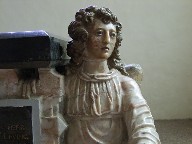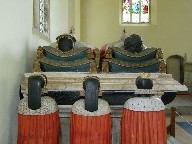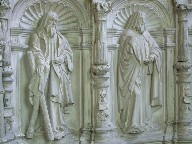| |
|
 |
|
Framlingham is without a
doubt one of East Anglia's most
attractive small towns. The main street
starts in the old market place and runs
northwards to the castle keep, and there
sits East Anglia's biggest castle. Across
the lake you can see the red brick
Victorian grandeur of Framlingham
College, a public school, and hafway
along the main street is another
grandeur, that of St Michael's church.
True, the town is not as busy as
Woodbridge, and doesn't have the same
range of shops, but then Woodbridge is full of the
kind of people who would live in a place
like Woodbridge, which I always find a
bit off-putting. There is no other Suffolk
church quite like St Michael. Suffolk is
famous for its naves, but the nave here
is almost hidden, squeezed between the
huge chancel, longer and wider than the
nave to which it is attached, the great
tower, and two ornate aisles. The pretty
clerestory peeps up in the middle, as if
the nave were standing on tip-toe to take
a look at the outside world. .
|
Wills specialist Simon
Cotton noted that quite a few bequests in the
last years of the 15th century left money for the
tower, although there is evidence that it hadn't
been started by 1500. This means it must have
been built pretty much in one campaign, the
battlements topping it out on the very eve of the
Reformation. But it is the chancel that makes St
Michael an extraordinary church. Whereas at
Lavenham, Long Melford and elsewhere, the
churches were rebuilt by the new money of 15th
century industrial Suffolk as great spaces for
public piety, here the rebuilding was effectively
an expedient measure for a landed family. The
Howards, the Dukes of Norfolk, residents of the
nearby castle, lost their family mausoleum at
Thetford Priory to the dissolution of the
monasteries in the 1530s. They built the great
chancel here as a new one, to be their final
resting place for generations to come. It wasn't
finished until 1554, after the brief but
militantly protestant intervention of Edward VI's
reign, when Mary I seemed to have brought some
stability to the English church again.
In these turbulent years of the mid-Sixteenth
Century, they had backed Catholic Mary's claim to
the throne against that of the protestant Lady
Jane Grey and seemed, for a brief while, to have
chosen the winning side. However, when Mary died
just five short years after her accession and
Catholic England was lost forever, their
patronage was not forgotten. The Howards retired,
licking their wounds, to their other castle at
Arundel in Sussex, leaving the new Church of
England a fascinating document of how the
Reformation years affected a great landed family,
a moment frozen in time. Framlingham's Catholic
community today meet in the nearby parish church
of St Clare, a bare shadow of this former glory,
although, ironically, their great Cathedral at
Norwich was built by a direct descendant of the
Howards.
I hadn't been to St Michael for years. I
was often in Framlingham, stopping for a rest in
the pub during a bike ride or cycling through
into the quiet low hills to the north, but in the
summer of 2013 I made my first visit since
recording a piece inside the church for BBC Radio
Suffolk some seven years earlier. It was the
hottest day of the year, and the roads were
nearly empty, because I had set off from Ipswich
as Andy Murray prepared to try and become the
first home tennis player to win the Wimbledon
championships for nearly eighty years. Everyone
was indoors with the curtains closed, away from
the heavy heat, slumped in front of their
screens. The only raucous noise came from
occasional pubs as I passed.
It was a pleasant ride, and
even more pleasant to sit on the bench outside
the church and eat a late lunch, the south side
of the building taking the full force of the sun.
I lazed for a while and then walked westwards,
stepping down into the cool, large porch and into
the body of the church.
The first impression is
that everything is neat and orderly, beautifully
kept and cared for. The north door opposite was
also open, and white light spilled across the
west end of the nave, making everything else
dark. It took my eyes a moment to adjust. I
looked up through the gloom to see the wall
painting of the Holy Trinity. This is a rare
representation, heartily disapporved of by the
16th Century reformers, but it was probably
painted over before then. God the Father holds
the crucified God the Son between his legs. You
can just make out the dove between their heads.
This is a survival from the earlier medieval
church, but there's not much else. Almost all
here is the rebuilding of the late 15th and early
16th centuries. Even as my eyes adjusted this
still seemed a gloomy interior, despite the
aisles and clerestory, but really, this was just
in contrast to the sea of light to the east,
where the chancel spreads beyond the chancel
arch, another surviving element of the earlier
building. The rood must have been a high one.
Above the west end of the church sits what
many people consider to be the greatest treasure
of this church, the organ. It dates from 1674,
although the case may be even earlier. It was
installed here in 1709, only to be moved into the
chancel by the Victorians. In 1969, reunited with
its case, which had spent a century in the castle
museum, it was returned to its rightful place at
the west end. The west end of the north aisle
beside it has been reordered as a prayer chapel,
which is rather lovely. The west end of the south
aisle is a shop, but this is not intrusive.
The font sits in the north
aisle. It is medieval, but seems recut.
Otherwise, the nave was restored sensitively by
the Victorians, and retains the feel of a serious
urban space which was no doubt intended by the
restorers. Beyond it, you step through the
chancel arch, where magnificence awaits. Ahead is
the altar, and beyond it an interesting altar
piece from the time when Laudian piety and the
beginnings of the Age of Enlightenment touched
fingers for a moment. It is an abstract image of
'Glory', dating from the early 17th century. It
is similar to those that can be seen in some
Cambridge college chapels (this church was
inherited by Pembroke College, Cambridge, in the
late 16th century). It did jolly well to survive
the Puritan terror. The chancel sprawls into both
aisles, a wide open space which is pleasingly
full of light. It is a perfect setting for the
tombs, which are, of course, what many people
come to Framlingham to see.
There are six of them, two to the south and four
to the north. There is room for many more, which
is clearly what the Howards intended. However,
one of those to the south is not a Howard at all,
which they certainly didn't. The four tombs to
the north of the altar are in chronological order
from the altar outwards, anti-clockwise. The
first is to Henry Fitzroy, one of Henry VIII's
many illegitimate children. The most remarkable
thing about it is the series of friezes around
its sides, depicting scenes from the Old
Testament.
  
Next to it,
against the north wall, is the tomb of two wives
of Thomas Howard, the fourth duke of Norfolk. He
was one of those who plotted against Elizabeth I,
in favour of Mary Queen of Scots, and his head
was neatly severed in the Tower of London as a
result. Beside this is a comparitively
understated tomb for the infant Elizabeth Howard,
daughter of one of the unlucky ladies on the
previous tomb.
 
Finally on this side, the
most recent tomb is for the fourth Duke's younger
brother Henry Howard, an enthusiastic Catholic
who was, not unreasonably some might think,
executed by the advisors to the boy King Edward
VI in 1547. This tomb actually dates from about
70 years later, and is the most spectacular of
all of them.
   
   
   
On to the south side of the
sanctuary, then. The first tomb is the second
oldest, and is for Thomas Howard, third Duke of
Norfolk and architect of this amazing mausoleum.
This man was a lackey of Henry VIII, but it all
went pear-shaped after the King's death, in terms
of both Henry's and Howard's successors.This tomb
may not be as spectacular as some of the others,
but it is important as the final statement in
England of religious imagery before the
Reformation - note the extraordinary series of
Saints around the sides. His beard is rather
awesome, too.
   
   
Finally, the tomb of Sir
Robert Hitcham, the interloper in this family
mausoleum. After the disgrace of the Howards
(they just couldn't shake off that Catholicism,
I'm afraid), the castle passed through the hands
of relatives until Hitcham bought it for a
wacking £14,000 in 1635. Unfortunately, he died
less than a year later. Hitcham was a great
benefactor to the town. Hitcham's castle is now
in the care of English Heritage, and may be
visited for a small fee. A walk along the curtain
walls is exhilarating and recommended.
   
Another famous name
associated with Framlingham is Thomas Mills, his
name remembered by that of the local High School.
He is not here, however. A staunch
non-conformist, he lived through the turmoil of
the Commonwealth and subsequent emancipation of
non-Anglican protestant communities, and was
buried in his garden. His estate continues to
benefit the town through the Mills Charity. His
descendants at Great Saxham have a mausoleum in
the church there.
| I remembered the
first time I'd visited Framlingham church
some 20 years before, knowing nothing
about it, and being pretty amazed by the
Howard tombs. There are nothing quite
like them elsewhere in the county. If
you have been to Wingfield or Dennington,
then to come here is to see something
quite different - not only had taste and
artistic expression changed in the
intervening centuries, but perhaps also
the way in which England's most powerful
and important family could memorialise
itself excessively and shamelessly
without worrying too much about what God
might think. I remembered on that first
occasion listening to two elderly
American tourists standing beside me as I
looked at Henry Howard's tomb.
"These Howards thought a lot of
themselves," said the lady,
"such arrogance!" Her husband
considered for a moment.
"Perhaps," he replied quietly,
"but they had a lot to be arrogant
about." I
stood for a while, and then walked
quietly back westwards into the 19th
Century, and out into the blissful
sunshine to cycle my leisurely way back
to Ipswich. Oh, and in case you are
wondering, Andy Murray won the tennis.
|
|
 |
|
|
|

